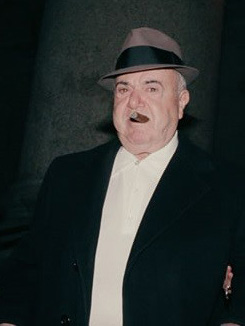What are Trump’s business ties to the Mafia? Casinos and Real Estate have long had a history. What do we know about his?
- TRUMP TENANTS lists felons, frauds, and other nefarious characters who have bought or leased space from Trump.
- TRUMP PROPERTIES discusses the circumstances of development.
- FELIX SATER, Bayrock LLC Trump Partner
- MONEY LAUNDERING
If not before, Trump had the entree into Italian Mafioso world via McCarthy-turned-Mafia attorney Roy Cohn, who became a mentor after Trump’s father died.
Wayne Barrett wrote “The Deals and The Downfall” in 1992 and investigated his mob ties. Barrett died from pneumonia the day before Trump’s Inauguration. “His 2000 book, “Rudy! An Investigative Biography of Rudy Giuliani,” revealed details about the criminal past of Giuliani’s father. In 2007, when Giuliani was in the midst of an ill-fated presidential campaign, Barrett reported that the former New York City mayor was the owner of four New York Yankees World Series rings, which he had purchased from the baseball club for far less than what they were valued on the market.” CNN.
 Fat Tony Salerno The Smoking Gun
Fat Tony Salerno The Smoking Gun
Just What Were Donald Trump’s Ties to the Mob? I’ve spent years investigating, and here’s what’s known.By David Cay Johnston As Barrett wrote in his book, Trump didn’t just do business with mobbed-up concrete companies: he also probably met personally with Salerno at the townhouse of notorious New York fixer Roy Cohn, in a meeting recounted by a Cohn staffer who told Barrett she was present. This came at a time when other developers in New York were pleading with the FBI to free them of mob control of the concrete business…lawyer Roy Cohn, who had become famous as lead counsel to Senator Joseph McCarthy. Among other things Cohn was now a mob consigliere, with clients including “Fat Tony” Salerno, boss of the Genovese crime family, the most powerful Mafia group in New York, and Paul Castellano, head of what was said to be the second largest family, the Gambinos.
- Mafia Controlled Concrete used in Trump Tower and NY Developments: “Trump chose a costlier and in many ways riskier method: ready-mix concrete. Ready-mix has some advantages: it can speed up construction, and doesn’t require costly fireproofing. But it must be poured quickly or it will harden in the delivery truck drums, ruining them as well as creating costly problems with the building itself. That leaves developers vulnerable to the unions: the worksite gate is union controlled, so even a brief labor slowdown can turn into an expensive disaster. Salerno, Castellano and other organized crime figures controlled the ready-mix business in New York. Trump ended up not only using ready-mix concrete, but also paying what a federal indictment of Salerno later concluded were inflated prices for it – repeatedly – to S & A Concrete, a firm Salerno and Castellano owned through fronts, and possibly to other mob-controlled firms. As Barrett noted, by choosing to build with ready-mix concrete rather than other materials, Trump put himself “at the mercy of a legion of concrete racketeers.” The risks this created became clear from testimony later by Irving Fischer, the general contractor who built Trump Tower. Fischer said concrete union “goons” once stormed his offices, holding a knife to throat of his switchboard operator to drive home the seriousness of their demands, which included no-show jobs during construction of Trump Tower. The indictment on which Salerno was convicted in 1988 and sent to prison, where he died, listed the nearly $8 million contract for concrete at Trump Plaza, an East Side high-rise apartment building, as one of the acts establishing that S &A was part of a racketeering enterprise.” Politico
- “FBI agents subpoenaed Trump in 1980 to ask about his dealing with John Cody, a Teamsters official described by law enforcement as a very close associate of the Gambino crime family…But a female friend of Cody’s, a woman with no job who attributed her lavish lifestyle to the kindness of friends, bought three Trump Tower apartments right beneath the triplex where Donald lived with his wife Ivana. Cody stayed there on occasion and invested $500,000 in the units. Trump, Barrett reported, helped the woman get a $3 million mortgage without filling out a loan application or showing financials. In the summer of 1982 Cody, then under indictment, ordered a citywide strike—but the concrete work continued at Trump Tower. After Cody was convicted of racketeering, imprisoned and lost control of the union, Trump sued the woman for $250,000 for alteration work. She countersued for $20 million and in court papers accused Trump of taking kickbacks from contractors, asserting this could “be the basis of a criminal proceeding requiring an attorney general’s investigation” into Trump. Trump then quickly settled, paying the woman a half-million dollars. ” Politico
Trump and the Mob
The budding mogul had a soft spot (but a short memory) for wise guys. April 27, 2017 The Marshall Project
“To help build his first big Manhattan project, the Grand Hyatt New York on East 42nd Street, Trump had chosen a notorious demolition company secretly owned in part, according to the FBI, by a top Philadelphia mobster who doubled as crime lord of Atlantic City. To pour concrete for the new hotel, Trump picked a firm run by a man named Biff Halloran who was convicted a few years later for his role in what prosecutors dubbed a mob-run cartel that jacked up construction prices throughout the city. For the carpentry contract, Trump settled on a Genovese family-controlled enterprise that was central to another mob price-fixing racket, as found by a subsequent federal probe.
And then there was the person who had introduced Trump to the FBI agents in the first place. This was a 6-foot-5 bear of a man named Daniel Sullivan, a former Teamsters leader who was serving as what Trump called his “labor consultant” at the time. Sullivan wore other hats as well: He was partners with a reputed Atlantic City mobster named Kenneth Shapiro who controlled the local scrap market and who was in the process of selling Trump a large plot of land at top dollar on which to build his casino.
Sullivan, who had once been close to Jimmy Hoffa, was also secretly operating as an FBI informant, filling in the Bureau on the various mobsters who crossed his path. I know this because Sullivan, who died of a heart attack in 1993, told me all about it, proudly providing copies of the FBI memos as proof. And Sullivan wasn’t just bragging. The FBI agents confirmed to me both the authenticity of the documents and the meetings Sullivan had arranged for them with the budding casino kingpin.”
In 1991, a federal judge, Charles E. Stewart Jr., ruled that Trump had engaged in a conspiracy to violate a fiduciary duty, or duty of loyalty, to the workers and their union and that the “breach involved fraud and the Trump defendants knowingly participated in his breach.” The judge did not find Trump’s testimony to be sufficiently credible and set damages at $325,000. The case was later settled by negotiation, and the agreement was sealed
